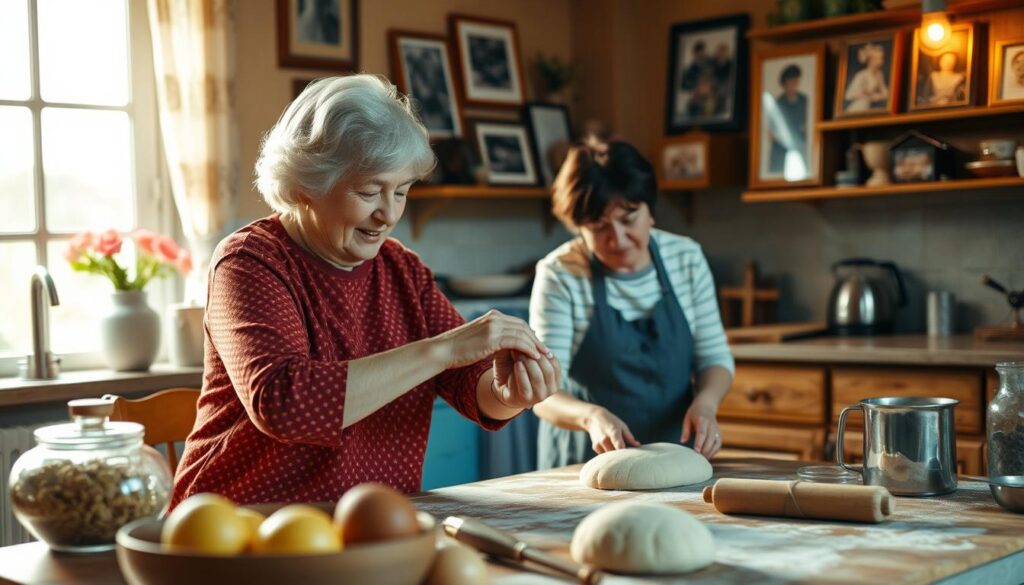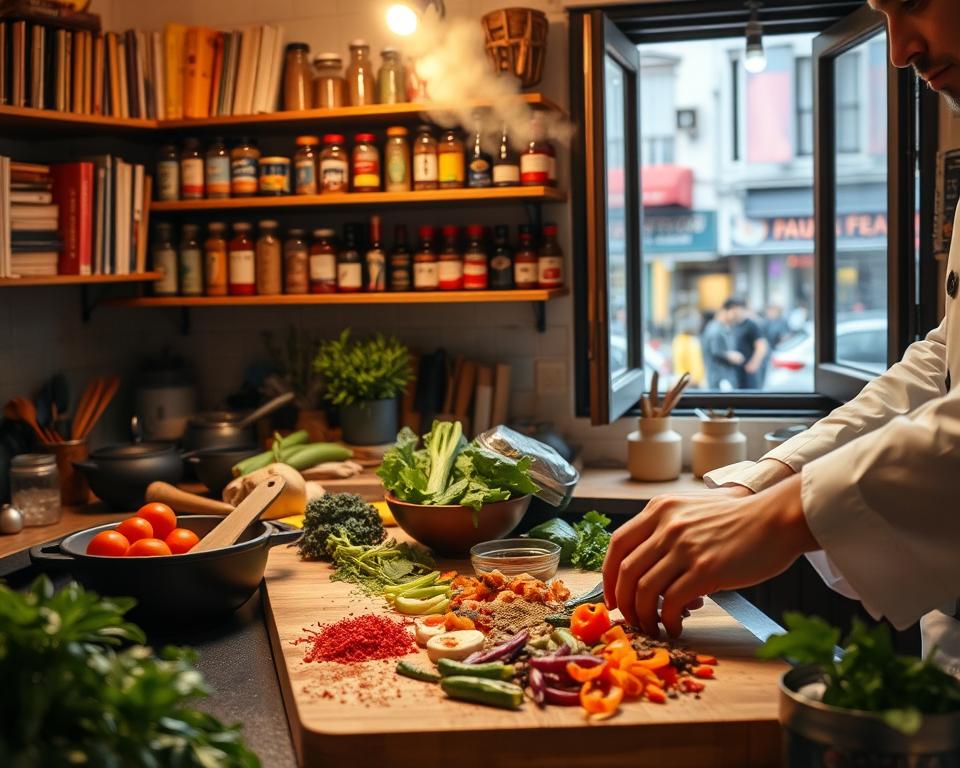Oznámení
Have you ever wondered how a recipe from one town becomes a beloved weeknight meal in yours?
Migration writes history on our plates. You’ll see how ingredients, techniques, and tastes move with people, carrying stories from one country to another.
In U.S. classrooms, teachers and students used shared recipes to build understanding. Comparing Ghanaian fufu—made from cassava and plantains with ginger, garlic, and peppers—with familiar American dishes revealed surprising links.
You’ll learn how spices and vegetables travel, how traditions adapt, and how cuisines grow richer when families share meals. This is not just about foods on a menu.
It’s about identity, memory, and the ways communities connect across the world. By following these stories, you start to notice how your own family meals fit a larger tale of movement, innovation, and respect.
Oznámení
Klíčové poznatky
- You’ll discover how migration reshaped what appears on your plate.
- Recipes act as living records of history and shared values.
- Simple classroom projects can deepen cultural understanding.
- Spices, vegetables, and techniques reveal global links to local dishes.
- You can honor traditions while enjoying new twists on familiar cuisine.
Ways migration shows up on your plate today
From shelf to skillet, migration shapes the flavors you cook and buy. You see traces of movement in simple, everyday choices.
Local markets now stock plantains, special flours, and spices that once seemed rare in the United States. That shift makes new ingredients feel like part of weekly routines.
From your family table to neighborhood restaurants
You taste migration at corner restaurants where owners share dishes from their journeys. Those menus mix past influences with present creativity.
Oznámení
At home, your family might fold heirloom recipes into new flavors you learned online, on trips, or from friends. Chefs also turn classic cuisine techniques into quick, weeknight meals.
Past influences, present flavors, future recipes
You notice a familiar dish arriving with an unexpected twist—different garnishes, new ingredients, or a fresh method. People swap recipes at potlucks and schools, passing along tastes that blend comfort and curiosity.
- You shop markets for ingredients that reveal migration histories.
- You dine at restaurants that act as gateways to new cuisines.
- You collect recipes that carry values, memory, and time forward.
In short, everyday foods connect you to a wider world. Each meal holds stories of people, movement, and evolving tastes that shape tomorrow’s dishes.
Family traditions that travel: recipes, memories, and identity
When students in North Carolina shared recipes with peers in Ghana, simple meals turned into teaching moments.
Ghana-USA pen pals: fufu, pizza, and shared stories
Teacher Kofi Prempeh connected his class in Johnson County with Wesley Girls’ Junior High. The students compared a bowl of fufu—pounded cassava and plantains with ginger, garlic, and peppers—with a slice of pizza.
Ghanaian students assumed Americans ate mostly vegetables from farms. American students were surprised that Ghanaian classmates also enjoy pizza. That back-and-forth helped everyone reshape assumptions and build understanding.

Passing down dishes to strengthen heritage in the United States
You keep identity alive when you write down recipes, memorize spice blends, and teach younger relatives why a dish matters. In the united states, passing recipes is less about taste and more about memory and pride.
- You link history and heritage through small ingredients and daily cooking.
- Shared recipes act as bridges between families and different cultures.
- Simple dishes show how cuisines travel and stay loved across people and places.
For more on how recipes teach understanding, see this piece on shared culinary traditions: shared recipes.
Slow meals, strong bonds: communal dining customs across cultures
When a table fills with small plates and a pot of steaming broth, conversation comes easy.
Dim Sum and Hot Pot: time, tea, and trust-building
In Hong Kong, Dim Sum means many small dishes shared over hours of tea and talk. Hot Pot invites everyone to cook together in a simmering pot at the center of the table.
Those long meals build trust. Traditions like the youngest clearing plates teach respect and pass on values.
Thai group dining: collectivist values over individual orders
In Thailand, groups order a wide mix of dishes to share. Diners accept mix-ups with a smile—“Mai pen rai”—and enjoy the meal as a group.
What you can adopt at home: shared plates and longer meals
You can slow your evening, pour more tea, and let stories breathe. Try a Hot Pot night or order family-style at restaurants to practice a less rushed way of eating.
- Sip tea and let conversation stretch for extra time.
- Serve shared plates so everyone reaches and tries new dishes.
- Invite the youngest to help clear up as a lesson in respect.
Icons of fusion: how migration reimagined beloved dishes
When people move, beloved recipes often find a second home with fresh twists. You see this in everyday menus and classroom kitchens.

Pizza and pasta beyond Italy: Immigration and global trade helped pizza and pasta appear across African and Arab countries. Chefs and home cooks use local ingredients and toppings, so these dishes carry both place and people.
Pizza and pasta beyond Italy: local twists from Africa to America
You’ll hear stories of family pizza nights where toppings mark a household’s history. In some countries, pasta takes on new sauces and spices that reflect local taste.
Curry and roti on U.S. school menus: techniques and spices on the move
In Florida, teacher Nanda Hafeez guided students through making chicken curry and roti from scratch. That lesson taught cooking techniques, the role of spices, and teamwork.
Seafood as a “special meal”: contrasting availability and value
Students from landlocked Zimbabwe learned that shrimp or crab can be treated as a special meal in coastal areas. Availability shapes how people value certain foods.
- Global classics adapt into comforting regional favorites.
- Classroom cooking makes recipes tangible and builds confidence.
- A single dish can tell stories of migration, technique, and taste.
Classrooms and communities as kitchens for understanding
When students chop, stir, and taste together, lessons on history and trust happen naturally.
In Palm Beach, Florida, geometry teacher Nanda Hafeez led students through making chicken curry and roti. The class learned cooking techniques, compared spice mixes, and noticed ties to Guyanese family traditions.
In Robeson, North Carolina, Anna Mae Flores invited neighbors for lumpia and leche flan and added karaoke to the evening. Music broke ice. Plates and songs made the neighborhood feel more like family.
“Sharing a pot and a playlist helped people see each other beyond labels.”
You build understanding fast when you cook together. Prepping ingredients and sharing dishes turn learning into a warm, hands-on experience.
- You see values like teamwork and respect as students assign roles and celebrate results.
- You gain appreciation for traditions by comparing rolling roti or spice blends.
- You watch community form when a group turns a classroom into a welcoming table.
Sečteno a podtrženo: these simple lessons show how recipes, techniques, and shared effort make diversity feel close and inviting across the united states.
Cultural food exchange in everyday life: markets, restaurants, and travel
Strolling a busy market can feel like reading a community’s pantry and past. You find stalls stacked with vegetables, spices, and small stories about where people came from and what they brought with them.
Local markets as living archives
Markets hold traces of the world in plain sight. Vendors point out rare ingredients and tell brief histories of how a dish arrived in town.
You learn names, seasons, and preparation tips that turn a shopping trip into an informal lesson in history.
Restaurants as gateways to new cuisines
Restaurants let you sample techniques and flavors you might not cook at home. Shared orders and long, group-style meals show you customs like Thai shared plates or Hong Kong’s long Dim Sum sessions.
Ask chefs about a method or spice. You can bring back a useful technique and a story to your own table.
Culinary tourism: tasting history and community
Pursue culinary tourism by joining a class or tasting tour. You will taste regional dishes, meet vendors, and map how cuisines moved between countries.
- Treat markets like tiny museums of ingredients and memory.
- Use restaurants to explore new cuisine and boost your cooking confidence.
- Bring home stories, techniques, and a deeper appreciation for how dishes travel.
Závěr
A single plate can map journeys across countries and generations. You see how food culture preserves cultural heritage by carrying recipes, techniques, and family stories beyond the kitchen.
In practice, small acts—asking about origins, crediting a cuisine, or inviting neighbors to share a meal—build appreciation and understanding. Pasta or a simple spice mix can tell history as clearly as a long recipe that a family passes down.
You leave with a plan: visit a local market, try a new restaurant, or host a cooking night. These ways honor heritage and welcome diversity, turning your kitchen into a spot where community, customs, and heart meet.



